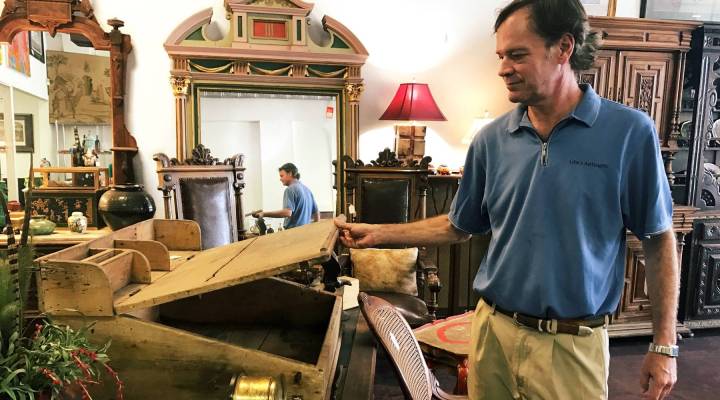
The one vintage thing that doesn’t appeal to millennials: Furniture
The one vintage thing that doesn’t appeal to millennials: Furniture

Millennials have now surpassed baby boomers as America’s largest living generation. That makes those in the 20-36 age range a driving force behind shopping trends. But it’s what millennials are not buying that caught our attention.
David Lackey is an appraiser on the long-running PBS series “Antiques Roadshow.” At his shop in an upscale neighborhood in Houston, Lackey said the market for antique furniture is down.
“Traditional English and American furniture, overall, has fallen maybe 50 to 75 percent,” he said. “There are half as many antique shows as there were 20 or 30 years ago.”
Art Market Research collects and analyzes art and antique data from major auction houses. It reports a nearly 40 percent drop in the value of English antique furniture in the past decade.
Lackey said the internet contributed to that by making items more accessible. When in the past it may have taken years to find an item, you can now instantly find 17 for sale at the click of a button. But there’s another factor: millennials who may not have inherited a love of antiques.
“The younger generation, for the most part, is not very interested in formal candlelight suppers,” Lackey said. “They don’t want silver, china, crystal, because they don’t intend to entertain that way.”
| Study: Millennials still struggling with student debt and underemployment |
| Why do we care if millennials are buying homes? |
In addition to changing fashions and personal preference, there are a few other factors that may be at play. When it comes to having space for those dining room sets, an increase in college tuition and the resulting student debt burden has resulted in falling home ownership rates among millennials. According to U.S. census data, only 34 percent of millennials are homeowners.
Millennials also entered the workforce during the Great Recession. They’ve experienced high unemployment. They also live with their parents longer than previous generations. Student debt has also changed spending patterns in the millennial generation. All of these factors point to lower disposable income. Millennials are more conservative than the previous generation in their spending and are less likely to buy luxury goods, according to Goldman Sachs.
Greg Nolte has owned “Gen’s Antiques,” also in Houston, for the past 14 years.
“The brick-and-mortar stores are suffering,” he said. “Our industry in particular is stuff you need to touch and feel, and know about. It’s very hard to sell online.”
Rachel Hernandez, 26, is a manager of a vintage clothing store. She thinks old is fine for clothing, but antique furniture misses the mark.
“Spending a couple hundred on something that my grandma has doesn’t work. It’s not ‘where it’s at,’” said Hernandez.
Still, antique dealer Lackey said what goes around tends to come around.
“A lot of things will come back,” he said. “Someday, the millennials, they may be horrified when their children want mahogany furniture and doilies and figurines. They may just think it’s horrible. ‘Why would you want that?’”
So maybe, in another decade, it will be time to start dusting off treasures in the attic.
There’s a lot happening in the world. Through it all, Marketplace is here for you.
You rely on Marketplace to break down the world’s events and tell you how it affects you in a fact-based, approachable way. We rely on your financial support to keep making that possible.
Your donation today powers the independent journalism that you rely on. For just $5/month, you can help sustain Marketplace so we can keep reporting on the things that matter to you.


















